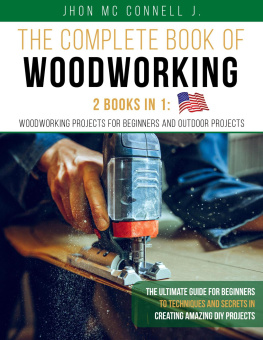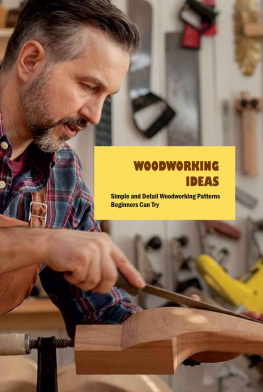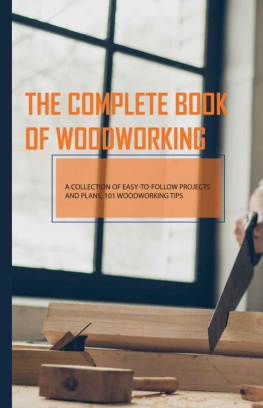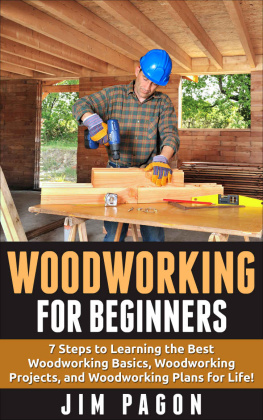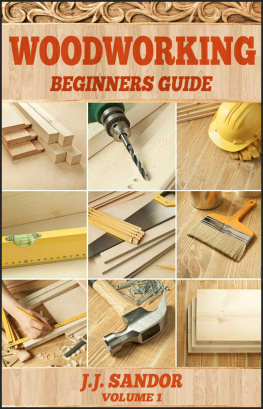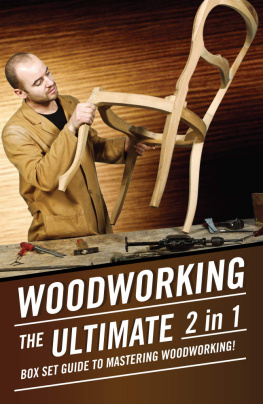Woodworking
The Best Tips, Shortcuts, and Tricks to Create and Sell Woodworking Projects
By Braden Terson
Copyright @2018
All rights reserved. No part of this book may be reproduced in any form or by any means without permission in writing from the publisher, Braden Terson
If you like my book, please leave a positive review on Amazon. I would appreciate it a lot. Thanks!
Contents
Introduction
Today's Woodworking Shop A Power Hungry Haven
Woodworking has become easier than ever before. When craftsmen in medieval times were making a living on this and hoping for their next scarce materials to arrive, they didnt have the power tools, jigsaws, drills, lathe, planer, and jointer that we have nowadays. There are a lot of people across the world who own their own woodworking business, and this shows that it is perfectly possible to make this hobby your profession, or to just do it on the side, of course.
Whatever your purpose is in woodworking, you need some guidance. You have to know what to do, what to use, how to do it, and where to look for inspiration. Thats where this book comes in. It paves the way for you journey of woodworking heroism and sophisticated carpentry in todays society.
For many people, the home woodworking shop is a safe place to escape from the stresses of family, obligations, or employment. The time doesnt matter; its all about the art. Some things are necessary, however, to make your time more useful and productive, and to make the process more enjoyable. One of the key items in any woodworking shop is the workbench. Most people will build their own to make sure it is sufficiently sturdy and balanced to withstand the beatings it is going to take. The bench has to be leveled and large enough to handle elaborate projects you may come up with.

Organizing and arranging tools in another thing you dont want to waste your time on. If you can arrange your tools according to the projects you are doing, it can save you tremendous amounts of time. This can prevent one tool from being in the way when you move on to the next part of your project.
These things and other important details will be addressed in the chapters ahead of you. To secure your safety, speed up the process, and perfect results, I encourage you to keep reading and not postpone this essential step in your woodworking endeavors: The right information.
I will see you in the first chapter!
Chapter 1: Tools
Naturally, the first thing you need to get started with woodworking, is a list of the right tools. If you have the right tools, you wont need to drive up and down to the store all day to add to your inventory. Figure out which tools specifically apply to your upcoming projects. A list of tools for carving will be an entirely different list from one that prepares you for cabinet making, for instance. It really depends on what you want to do, so a set tool set is not always something every carpenter needs to acquire.
Hand tools and electric tools are different as well. If you are more of a hobbyist, you might want to go the traditional route and use more hand tools. If you are trying to scale up or start a business, the modern-day tools that get the job faster, might be a better fit for your plans. Power tools are great nowadays, and it will depend on your project how much you should invest into these things.
When you know what you want to do, it may be good advice to take some classes or look up some more specific steps online. However, many projects include both, so they require you to use some hand tools and some power tools. The space is also a determining factor for the kinds of projects you can do. If you are trying to do woodworking in a small shop, you obviously lack the means to create an entire porch or a shed. If you do something outside, and if the weather is good enough, there will be more options for you.
Lets get to the point and give you a list of handy tools you may or may not use when youre woodworking. If you downloaded the E-book version, you will see some links to various tools you can easily add to your cart in the Amazon shop. I personally recommend these, but of course you can browse around and find yourself a better deal, a lower price, or a different brand if you want.
1 Utility Knife
(Click on this LINK to look at one on Amazon)
The one that uses disposable blades, is the most common. The blade retracts into the grip for safety reasons. Carpenters and woodworkers use them when they are cleaning out mortise joints or scribing wood. These are just two examples of what you can use it for.
2 Claw Hammer
(Click on this LINK to look at one on Amazon)
( Click on this LINK to look at one on Amazon)
Claw hammers have either a rounded head or a waffle-head, the latter of which leaves a waffle mark on the wood when you put the nails in, but this is only often used in construction. If the claw hammer isnt balanced well enough, your hand will twist and turn and make it harder to drive in the nails the way you want.

Grab it at the back, so that the hammer does the work for you. A 20 oz. sized one is the most common claw hammer. The best thing to get, is one with a steel handle, or with fiberglass. Wooden handles might not be strong enough against the strain of forcing a lot of nails into the wood. Wooden-handled ones, however, will be more effective for decreasing stress on your hand and wrist. Again, if the link doesnt show the right tool for you, just keep browsing around until you find the right one.
3 Tape Measure
(Click on this LINK to look at one on Amazon)
Get one which is about 25 feet long. If it is longer than that, rolling it back up will be more difficult. Make sure the hook or tab at the end is tightly attached to it. If it loosens up, you may start having accuracy problems in your project. One person told me, Measuring is knowing. This way, you are sure. You have the facts, and you dont have to guess or estimate.
4 Screwdrivers
(Click on this LINK to look at one on Amazon)
( Click on this LINK to look at one on Amazon)
This is a must-have when youre woodworking. Not only will you need Phillips and slot, or flathead screwdrivers, youll need star drivers and Torx drivers, too. Screwdrivers determine much of how the project will develop. You must have a long screwdriver with a square blade that is heavy duty. Dont skim the surface on this. It gives you a lot of torque. You should also get a small and medium slot screwdriver. If you want to put cabinets together, or you are working in a small space, you will also need a screwdriver with a thin shank to be able to reach screws inside of the deep holes. Cabinet screwdrivers are excellent for doing the job. Some more tips for screwdrivers:
Use the correct blade size for screws.
If you encounter a stubborn screw, place the driver into the screw, add as much downward pressure as possible on the screwdriver, and hit the back of it with a hammer. Most likely, the screw will pop out. You can also apply this to screws which have stripped out.
You can smear beeswax on the threads of screws before you drive screws into hardwood. Soap is another alternative. It helps the screws drive smoothly.
A shorter tank will help you get more driving force.
For more torque, make use of a crescent wrench on the blade.
There are woodworkers who are capable of magnetizing a screwdriver by holding it up and beating it with a metal bar. It can realign the molecules and cause it to be magnetic. Its also possible to break your screwdrivers doing this, so be extra careful when you try this!
Next page

